In accordance with German plans at the very beginning of the occupation, the
Lublin district was intended to become "the pillar of the
Generalgouvernement’s agriculture". In order to modernize the agriculture in this region, the German
authorities (mainly the civil administration) wanted to regulate the small rivers and to improve the
meadows. Therefore the
Wasserwirtschaftsinspektion (Inspection for Water Economics) in the
Lublin district installed a network of small work camps in
1940. Jewish and Polish prisoners would work there.
Chelm County became one of several centres for these camps.
The Sobibor extermination camp was built in this district in
1942.
In
1940, Jews (mainly from
Lublin and
Warsaw districts) were sent to these work camps.
Their official salary was 96 Zloty per month; but this amount was not nearly enough
considering the extremely hard work.
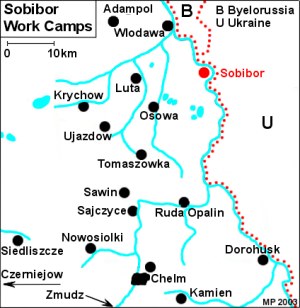 |
| Sobibor Work Camps |
These forced labour camps were set up in the swampy surroundings of Sobibor:
Czerniejow, Dorohusk, Kamien, Krychow, Luta, Nowosiolki, Osowa, Ruda Opalin,
Sawin, Siedliszcze, Sobibor-village, Staw-Sajczyce, Tomaszowka, Ujazdow, Wlodawa and
Zmudz.
In some places the camps were located in school buildings, abandoned farms or industrial buildings.
Except for the
Krychow camp, the prisoners lived in barns, on private farms or in a
mill (in
Staw-Sajczyce). The camps were under the supervision of the German civil
administration but the prisoners were guarded by
Trawniki men or by Jewish police
(in
Osowa). In
Sawin, the Jewish prisoners
were supervised by Jewish police and Polish guardsmen who worked for the
Wasserwirtschaftsinspektion.
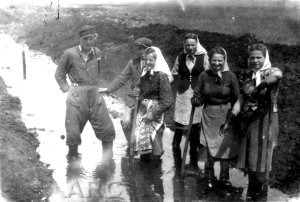 |
| Sawin Work Camp #1 |
The prisoners were forced to work 8-10 hours daily. Most of the time they stood in the
water in wet clothes, without the opportunity of changing them. Food was always a
major problem. Only those who came from towns close to the camps had the opportunity
of obtaining some food from home. The Jews taken from the
Warsaw Ghetto or the
Warsaw district depended on the camp's kitchens. If they had some money
they could buy bread from the local peasants. In some camps, like
Krychow, the prisoners were killed when
camp commander
Adolf Löffler discovered contacts
with local Poles. The Polish farmers accused of selling food to the prisoners, were
beaten. In
Osowa these contacts were not so strictly forbidden. Because they had no
money the Jews exchanged their clothes for food.
In
1941 alone, 2,500 out of 8,700 Jews from the
Warsaw Ghetto had to be released from
the camps because of sickness. Many Jews died of starvation, typhus epidemics and very
hard work. In several camps, like
Osowa or
Sawin, they were shot in mass executions.
In
autumn 1941, in
Osowa, the last remaining group
of 58 Jewish prisoners were executed close to the camp. Two of them survived and became functionary prisoners
in the next period,
between 1942 and 1943.
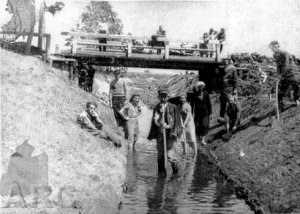 |
| Sawin Work Camp #2 |
In
1941, about 2,200 Jews from the
Warsaw Ghetto were sent to
Krychow, Osowa, Sawin
and
Staw-Sajczyce. The number of people who were released from these camps during
June/July 1941 (when almost all large buildings were taken over
by the German
Wehrmacht in the course of the beginning of the war against the Soviet Union) is not known.
In
Osowa the average number of prisoners was 400-500 people, in
Siedliszcze approximately 2,000, and in
Sawin 700-800.
Krychow was the biggest camp of this network, located south-west of Sobibor close to
Hansk village. It was built before the war as detention camp for Polish criminals.
Even then the prisoners had to regulate the rivers of this region.
In
1940, the
Hansk local administration received an order from the German civil administration
to prepare buildings of the former camp for Gypsy transports. These were relocated from
their camp in Belzec. The whole group has been estimated at between
1,000 and 1,500 people. According to the statements by Polish witnesses from
Hansk, the Gypsies in
Krychow were not
guarded and not forced to work. Most of them could not speak Polish. They exchanged their
clothes for food and begged for money. In
autumn 1940, they were deported from
Krychow. Some of them were sent to the
Siedlce Ghetto.
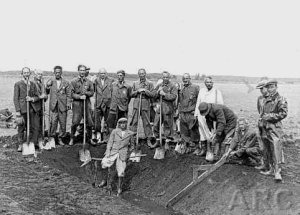 |
| Sawin Work Camp #3 |
Between the end of 1940 and early 1941, most of the prisoners in
Krychow were Jews from the
Warsaw Ghetto and local Polish and Ukrainian farmers, arrested for not having paid
their impositions. Around 1,500 prisoners in
Krychow (according to witnesses in
Hansk)
were beaten by the guards and suffered from starvation and illness. 150 Jews worked as
manual workers. Many Jews had to work on fields which belonged to the German "colonists",
or at the manors taken over by Germans. Even women and children (8-12 years old) had to
work there. With the beginning of
Aktion Reinhard all of these forced labour camps were
reserved for Jews only. After their families paid for them, the Polish and Ukrainian
prisoners were released at the beginning of
1942.
The Jews arrived from liquidated ghettos in the surroundings of Sobibor:
Rejowiec, Siedliszcze, Sawin, Wlodawa and
Chelm or were sent after selection in the Sobibor death camp. In Sobibor
the transports from abroad were selected on the ramp. People from Slovakia,
Terezin (Theresienstadt),
Germany and Austria did not realize or could not believe that they were standing on the ramp
of an extermination camp, that a few meters away their relatives and friends were being
murdered! Sobibor was probably the only extermination camp of
Aktion Reinhard at which the
SS selected bigger groups of Jews for work in another camp. It is unknown how many persons
were selected at Sobibor for work in the forced labour camps (e.g.
Budzyn,
Trawniki,
Poniatowa, and
Dorohucza).
 |
| Sawin Work Camp #4 |
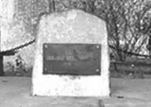 |
| Adampol Memorial |
Apart from the difficult conditions of life and work (in spring and summer mosquitoes
were a big problem), selections in the camps were regularly organized. Sick people
and children were sent by horse-drawn vehicles or by foot to Sobibor death camp. In
the camps which were very close to Sobibor, the inmates knew about the death camp.
This psychological pressure shattered their will to resist and survive. In many Polish
testimonies, the witnesses mentioned the passivity of the prisoners. In
Osowa village,
7 km away from Sobibor and surrounded by a big forest, no prisoner escaped from the
camp although some Poles attempted to help them. Only during the final liquidation
of the
Adampol Work Camp near
Wlodawa (on
13 August 1943) did some
of the prisoners who
were in contact with partisans, try to organize some resistance and fight against the
police. It is important to mention that most of the inmates in
Adampol were Polish
Jews who knew their fate. During the liquidation of this camp 475 Jewish prisoners were
executed on the spot. Most of the foreign Jews had no possibility of escaping because
they did not know the local population and region. Especially for Jews from Germany,
Austria or Holland (
1943) the language barrier was a huge problem. In
Sawin successful
escapes by two Czech Jews are known. One of those who escaped, who lost his mother
during the selection in
Sawin, only found out after the war that his camp was not
far away from the death camp in Sobibor.
In other camps the biggest group of prisoners were Jews from outside Poland.
Polish witnesses very often mention their close contacts with Czech Jews. Polish farmers
realized that among the deportees were Jews who had converted to Christianity.
For example in
Sawin a dentist from Czechoslovakia was a member of the church choir
and her son played the violin during mass. Christian Jews from Czechoslovakia were
also in
Krychow:
"
Among the Jews who were in the camp in Krychow there
were also Catholics. I saw how during the transport to Krychow some of
them stopped before the cross which was close to the street, and they crossed themselves and prayed. I saw
also that some of them wore small crosses on the chest." (Statement of
Zygmunt Leszczynski from
Hansk)
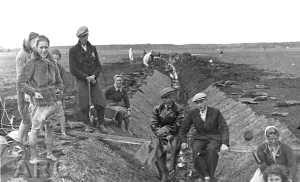 |
| Sawin Work Camp #5 |
In
summer and autumn 1943, most of these camps were liquidated and their inmates
were sent to Sobibor. From
Krychow the prisoners were taken on horse-drawn wagons.
From
Sawin they had to walk and many of them were killed on the way to
the death camp:
"
I remember, we were together with my father in front of our house, 5-8 m away from the street.
Suddenly we saw the "Kalmuk" (probably a Ukrainian guard), and behind him several hundred marching people in
a column. They walked very slowly and looked starved and dirty. Several of them took off their hats and told
us words of farewell: "Good bye Mr. Stankiewicz, we are going to the fire."
(Statement of
Henryk Stankiewicz from
Sawin).
 |
| Sawin Work Camp #6 |
After the selections in the labour camps and during their final liquidation the Germans
forced the Polish farmers to use their horse-drawn wagons to transport the old people
and invalids. Just before the gate of the death camp in Sobibor the Poles had to abandon
the wagons and Ukrainians from the camp drove the wagons through the gate. Then the Poles
heard the victims screaming and after one or two hours the wagons were brought back to them.
Probably the last liquidated camp was in
Luta
village. The camp existed, according to the testimonies of local inhabitants, until the Sobibor
uprising on
14 October 1943. The inmates from
Luta observed a group of Sobibor prisoners who tried
to escape to the nearby forest. After the uprising the Jews from
Luta were taken to the death
camp for extermination.
In
Osowa a small cemetery is to be seen with graves of prisoners who died there.
It is very difficult to say how many people passed through the Sobibor work camps or perished
there. The subject - small work camps within the death camp's surroundings - is not generally
known among historians and requires further research.
Sources:
Archive of the Institute for the National Remembrance in Lublin: Documents about the
Investigations on the Mass Crimes in the Work Camps in Krychow, Siedliszcze and Adampol.
State Archive in Lublin: Collection of the Governor of the Lublin District.
Interview with Mr. Stefan Ostapiuk from Osowa, private collection of R. Kuwalek.
T. Berenstein: Obozy pracy przymusowej dla Zydow w dystrykcie lubelskim. Biuletyn ZIH, nr 24 (1957).
T. Berenstein: Zydzi warszawscy w hitlerowskich obozach pracy przymusowej. Biuletyn ZIH nr 67 (1967).
E. Dziadosz, J. Marszalek: Wiezienia i obozy w dystrykcie lubelskim w latach 1939-1967. „Zeszyty Majdanka”, vol. III (1967).
J. Krasnodebska: Przyczynek do historii getta w Sawinie. „Rocznik Chelmski”, vol. IV (1998).
J. Marszalek: Zydzi warszawscy w Lublinie i na Lubelszczyznie w latach 1940-1944. (in) Zydzi w Lublinie. Materialy do dziejow spolecznosci zydowskiej Lublina. red. T. Radzik. Lublin 1995.
© ARC 2005
















